Almost every building requires proper matting. When designing any place like home, restaurant, gym, apartment, kitchen, industry, etc, the floor should be given great importance. Floor mats are used to maintain the building clean by trapping dirt and dampness, preventing slippage, protecting the floor, and preventing sliding. The initial investment in high-quality floor mats will pay off in the long run for the visitors. If you’re planning to buy one, don’t forget to read the reviews in the UK.Collected.Reviews.
What’s in this guide?
This guide will help you to buy floor mats and clear all your confusion regarding floor mats. This guide will answer your 3 questions i.e.
- • Why do we need floor mats?
- • What materials are used to make floor mats?
- • What are the types of floor mats?
If you wonder how you can buy the best one, read the online shopping experiences of other people who purchased before you and leave their opinions and feedback.
There is no one-size-fits-all matting option because different locations have varied demands, floor mat manufacturers provide a diverse selection of matting alternatives. Of course, if you're not sure which type is best suited for your needs, the quantity of floor mat possibilities might be overwhelming.
Interlocking Baby floor mats are also available that are most suitable when bought foam mats.
Why do we need floor mats?
Comfort
Standing for long periods might be problematic in the office. People benefit from padded anti-fatigue matting and other matting choices because they reduce stress on their bodies. Contact with hard surfaces can cause a variety of health problems, ranging from poor posture and exhaustion to back problems and misalignment. Supportive matting decreases stress, allowing workers to stay healthy and rejuvenated while also improving morale by making their work environments more pleasant.
Cleanliness
Clean-up is made easier with the use of good flooring. Wet area mats are meant to enable liquids to flow through to the ground, preventing employees from slipping and allowing messes to be swiftly cleaned up. Certain mats are also engineered to not break down when exposed to a variety of work materials and cleaning chemicals, allowing them to be reused.
Floor protection
It is costly to install new flooring. There are several situations when floor damage is a serious possibility. Black marks and scratches caused by dirt and debris, as well as impact damage from heavy machinery or other things, are all examples of this. Floor mats may be constructed to take the brunt of these harmful impacts, helping you to protect your base.
Anti-static
Through grounded cables, floor mats may be constructed to avoid electrostatic build-up and deflect electric pulses away from devices, safeguarding both electrical devices and your bottom line.
The material used to make floor mats
To make floor mats, manufacturers use different types of materials because all the materials have their functions and properties. It's a simplistic product with an uncomplicated building method. However, there are several factors to consider when designing a mat that is both attractive and secure. Bevelled edges, recessed water dams, and high-traction backings all need a degree of engineering knowledge you may not expect to find in a doormat. Based on the material used, it is decided where a floor mat should be placed. The most common materials are;
Vinyl
Vinyl floor mats are made up of a plastic polymer called vinyl. They are quite inexpensive and an alternative to rubber floor mats. They don’t absorb water and have tough backing which is a good option.
Rubber - Good for kitchen floor mats
Natural rubber is used to make rubber floor mats. Rubber floor mats are extremely durable and may endure for years. For high-traffic locations, such as commercial businesses, rubber floor mats are advised. This not only enhances the aesthetic appeal of rubber floor mats but also guarantees that they give grip on slick surfaces. Most rubber floor mat manufacturers add an absorbent foam or carpet material to the topside of the floor mat to improve its functioning.
Carpet Fibre - Good for gym floor mats
Floor mats are also made from carpet fibres. The surface of carpet floor mats is made of a garment fabric with strong fibres. These mats come in a variety of colours and have wonderful stitching designs. Carpet floor mats are absorbent, which is one of their main advantages. These mats are commonly used as entry mats, absorbing water and moisture from users' shoes. Carpet floor mats can also have a durable rubber or vinyl backing to improve their quality and longevity.
Types of mats
According to the usage of mats, here we defined some types of floor protection mats that you should look for;
Entrance mats
Entrance mats are the first defensive thing in controlling the dust to enter the building. They are used inside and outside of the doors and extended to 8 to 10 steps of a walker - known as a long floor mat. They are commonly made of vinyl. Their borders are designed in such a way that they absorb moisture and prevent the floors from contacting the dampness.
Scraper mats
Scraper mats are usually made up of rubber which commonly has raised finger styled patterns to absorb dampness and dust from the shoes. When wet, their surface gives additional traction, reducing the chance of falling. They are usually unaffected by grease or oil, which helps to safeguard guests from slipping on slick hard floors. Their backing is vinyl which makes it slip-resistant. Mostly, we have kitchen floor mats as scraper mats.
Wiper mats
Wiper mats are made of durable materials like olefin and microfiber. For the best performance, wiper floor mats are usually used in combination with scraper mats. They're made to absorb water while also trapping dirt and dust particles. The vinyl and rubber backing is present which makes it slip-resistant. Moreover, it doesn’t shift due to the backing.
Anti-fatigue mats
These mats are made to relieve stress on feet and legs from standing in the same posture or place for extended periods of time. They have a multilayer construction with a core that allows for regulated compression while in use. The mats are "soft to the touch," compressing when you step on them, stimulating the muscles in your feet, legs, and lower back. Heated floor mats also come in customizable options to design your floor mat.
Oil absorbent mats
These mats are specially designed to absorb oil or grease and avoid slips. Oil absorbent mats are best utilised in places where there is a lot of oil or grease. They can be utilised in business garages or warehouses where there is a risk of oil or gas leaking from machines. Moreover, it prevents oil and grease from dragging around your building. That’s why it is also called a superabsorbent floor mat.
Drainage mats
The only function that drainage mats perform is to let liquid easily pass through them without stopping at a place. They are backed with rubber to make them slip-resistant and avoid shifts. Mostly, they are black floor mats and grey floor mats as they have nothing to do with the home decor.
Keep your spa area clean!
To keep your spa area clean, there are interlocking hot tub floor mats. They are simple to assemble and will give you a slip-resistant floor along with clean surroundings.






